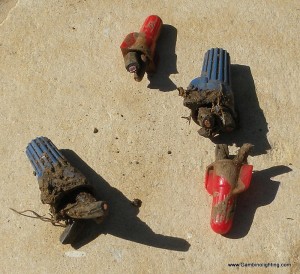22 Jul Poor wire splices are a big problem in a low voltage landscape lighting system
By Mike Gambino
Poor contacts are the cause of more problems than all other low-voltage lighting installation errors combined. Poor contacts or loose connections cause friction which in turn produces heat. This heat will compromise both the safety and aesthetic qualities of any low-voltage lighting system.
The problem can begin at the point of origination in the terminal blocks within a transformer. The first concern before beginning an installation is that the terminal blocks must be of sufficient size and design to accommodate the ampere rating of the particular transformer plus 50% (UL 1838). This is a matter regarding the manufacturer of any outdoor lighting transformer.
When it comes to installation, once the wires are inserted into the terminal block, it is of utmost importance to tighten the contact screw to the maximum extent. Once the contact screws have been appropriately tightened, they need to be vigorously tugged on up and down, back and forth, etc… This settles the wires within the terminal block and will allow you to further tighten the contact screw at least an addition half turn. This is to be done every time, without exception. Transformer cable to lug Connections should be checked at each and every maintenance visit.

Wire nuts should never be used to connect outdoor lighting cables that are directly buried in the ground
Loose connections in the cable runs can also create heat. Therefore, any splices in the cable runs must be made with an approved (UL or CSA) method. A twist on connector is not approved for direct burial. The piercing point connectors are a continual source of corrosion. Either of the two result in poor contacts which generate heat and reduce voltage being delivered to the lamp. This will diminish light output and system effectiveness and reliability. So why are they still used? Because they are cheap and the installer who installs such poor and unacceptable connections won’t be around when the troubles occur.
From a troubleshooting standpoint, cable splices should never be made more than six inches from the fixture. Running a “Home Run” to a hub is really asking for poor contacts especially with twist on or piercing connectors and underground splices.
It is in the best interest of everyone to minimize any underground splices whenever possible.
These practices will assist with designing and installing low-voltage systems in a way that minimizes the production of heat. Moreover, they will further ensure that you have a beautifully functioning and safe outdoor lighting system.

Gambino brass lug connectors are weatherproof and the best choice for low direct burial cable connections
This landscape lighting blog is published by Mike Gambino of Gambino landscape lighting inc. all rights reserved. Mike is a professional landscape lighting system designer/ builder and has been designing, installing and maintaining landscape lighting systems for more than 20 years. Mike resides in the Los Angeles area with his wife and 2 sons. To visit his website go to www.gambinolighting.com . To inquire about hiring Mike please click here .
Blog articles may be published with permission on other websites without editing or removing links.




No Comments